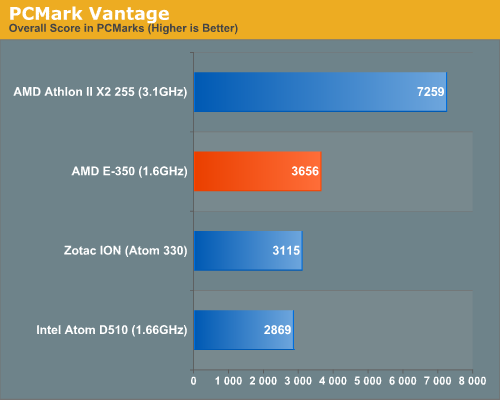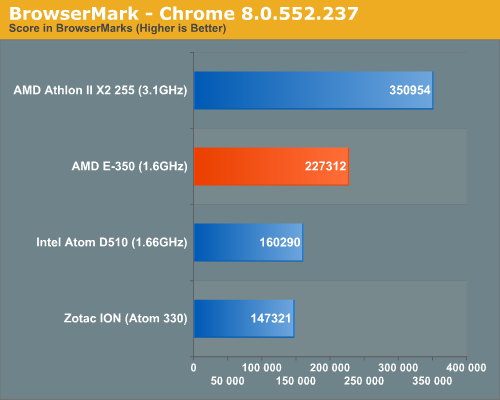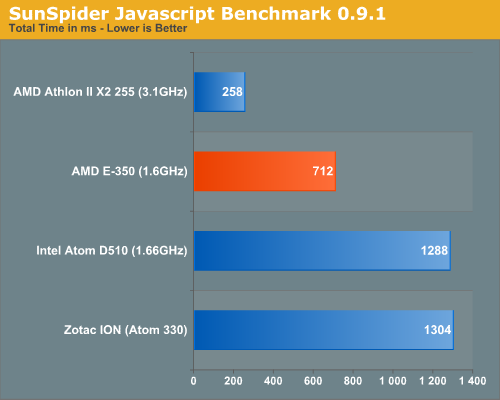The Brazos Review: AMD's E-350 Supplants ION for mini-ITX
by Anand Lal Shimpi on January 27, 2011 6:08 PM ESTGeneral Performance: In Between Atom and Athlon II
Atom may be efficient and fast enough to run a smartphone OS, but it absolutely chugs on Windows 7. The seat of the pants feel of an AMD E-350 is noticeably better. Single threaded performance, as you’ll soon see, is easily twice that of a similarly clocked Atom. Bobcat is still a dual-issue dual-core machine so high IPC or highly threaded workloads will show little difference between it and Atom. Thankfully, for most entry level netbook/nettop workloads Bobcat’s architecture should be sufficient. Before we get to the more CPU intensive tests I wanted to run through some reader requests for performance characterization.
I’ll start out with PCMark Vantage. There’s very little that separates PCMark from SYSMark in terms of how realistic the workload is. Neither suite is particularly representative of what an average user does today. What these suites are good at is being very long, and stressing enough aspects of a platform to give you a general idea of performance. SYSMark tends to focus on the more heavy user/content creation side of things (optimized for no more than 2 cores), while PCMark Vantage is much lighter test.
Looking at SYSMark you’d see no performance difference between the E-350 and Atom. The reason is simple. SYSMark was designed to be a modern day CPU benchmark. Most of the workloads exhibit high IPC and thus Bobcat’s front end acts as a bottleneck.
While SYSMark can be useful in estimating how a processor might handle particular heavy workload, it’s not useful in characterizing the sort of light workloads that you’d see a netbook or nettop user creating. PCMark Vantage is a collection of far simpler tasks. Again not specifically what you’d do today, but lighter nevertheless.
I compared four systems using PCMark Vantage, all with the same memory and I/O configuration. I dusted off an Atom 330 + ION motherboard from Zotac, an Atom D510, the MSI E-350 board and an Athlon II X2 255 on an 890GX motherboard. I picked the Athlon II simply because it’s a very affordable (~$65) modern day dual-core CPU. The Athlon II will help put the E-350’s performance compared to modern day x86 cores in perspective.

The E-350 holds a clear advantage over the Atom D510. The overall suite runs 27% faster on the E-350 than the D510, and even 17% faster than ION (the overall suite includes some GPU tests where ION makes up for Atom). The advantages vary from 10 - 80% in most cases. If you look at tests where the GPU is involved, you have to start counting how many times Brazos is faster than Intel’s current Atom platform.
I have to put the E-350’s dominance in perspective however. An Athlon II X2 255 still delivers nearly 2x the performance of the E-350 in PCMark Vantage. Just as the Atom to E-350 jump is noticeable, so is the jump from an E-350 to an Athlon II.
A performance advantage in PCMark is often difficult to visualize so let’s move on to some more application specific tests. Next up are two web browser benchmarks we typically use in our smartphone reviews: BrowserMark and SunSpider.
BrowserMark is a general purpose browser test. Rather than loading full web pages it tests rendering speed for commonly used components of web pages and presents one gigantic score at the end to tell you which platform is faster. The benchmark is obviously browser dependent so I ran all numbers on the same version of Chrome (8.0.552.237). The test platforms were the same as before:

The E-350 holds a 41% performance advantage over the Atom D510 here. That’s definitely enough to be noticeable in actual usage. In general web browsing is noticeably faster on Brazos than on Atom. The Athlon II is another 50% faster than the E-350. Again, it’s enough to be noticeable.
SunSpider is a collection of javascript benchmarks that we typically run to compare smartphones. It ends up being a good way to compare one aspect of web browsing performance between these entry level platforms.

The Brazos advantage over Atom actually climbs when we look at pure js performance. The E-350 is 80% faster than the Atom D510 here. The Athlon II advantage grows as well. Web browsing can be very CPU bound at times.
Brazos, like Atom, will never compete with its bigger brothers. There’s only so much you can do with a very tiny die. What AMD’s platform does provide however is a stepping stone between Atom and the lower end beefy x86 cores, which is something we’ve needed.
Many of you wanted even more real world testing, focusing on things like application launch time and system boot time. Ask and you shall receive is one of our policies around here (within reason) so I put together a drive image with a ton of applications, games and data. I measured the time it took to boot to the Windows 7 desktop as well as timed individual application launches.
Boot time is a difficult thing to compare between platforms. Everything from BIOS optimizations to the type of video card you have in the system can impact boot time. In this case, the E-350 system managed to boot 13% faster than the Atom system.
Individual applications, specifically light weight apps (e.g. Google Chrome, Media Player Classic), launch relatively quickly on both Atom and Brazos. This is largely due to the fact that I’m testing with an SSD. Regardless there’s still no appreciable difference in launch time between the platforms when the drive bottleneck is removed (the difference doesn’t grow as you add bottlenecks in). Where we see the E-350 really shine is in the larger, more complex applications and games.
| Application Launch Time Comparison | |||||||||||
| Platform | Boot Time (POST to Desktop) | Adobe Reader 9 | IE8 | Chrome | MPC-HC | Cinebench 11.5 | Sonar 8 | CoD: Black Ops | Starcraft II | ||
| AMD E-350 (1.6GHz) | 61.5s | 2.2s | 1.4s | 1.4s | 1.2s | 5.5s | 8.8s | 15.0s | 21.9s | ||
| Intel Atom D510 (1.66GHz) | 70.3s | 1.5s | 1.4s | 1.4s | 1.2s | 3.9s | 10.3s | Fail | 39.8s | ||
| AMD Athlon II X2 255 (3.1GHz) | 53.8s | 1.0s | 0.8s | 0.7s | 0.7s | 2.5s | 4.5s | 5.3s | 9.9s | ||
Sonar 8 launched 17% faster on the E-350 vs. Atom, while Starcraft II launched in almost half the time of the Atom D510 (although I suspect part of the advantage there is GPU related). Not all application launches were faster on the E-350. Occasionally applications would launch faster on the D510, but that seemed to be the exception rather than the rule. Overall system performance is naturally faster on Brazos compared to Atom.
Bring the Athlon II into the picture and things look different. You can cut most of Brazos’ launch times in at least half to get an idea of the Athlon II’s performance.










176 Comments
View All Comments
nitrousoxide - Thursday, January 27, 2011 - link
That's cool. When Intel owned everything, try buy a Core i5 with $200 as today. Actually, I'm not quite sure if an i3 will cost less than $150.And that's what happened during G80 era. nVidia has the best GPU, much much faster while the R600s are craps, ATI's on the edge of extinction. See what you got? $1000 for the flag-ship 8800 Ultra, $600 for a high-end 8800GTX. A decent card may cost you $400 (8800GTS) and even a crappy (though not as slow as Radeon 2600) 8600GT costs you $250.
Enlightenment777 - Thursday, January 27, 2011 - link
Rumors, Rumors, Rumors, Reviews, Reviews, Reviews, when can we buy E-350 motherboards from NewEgg?GTaudiophile - Thursday, January 27, 2011 - link
What are the differences between high- and low-end HTPCs?I am thinking of making a combo HTPC/NAS box of sorts...playing the role of both media streamer (online content, mkvs, etc.) as well as a storage box for machines on the network.
Will this do it? With what OS?
djfourmoney - Thursday, January 27, 2011 - link
Go to the AVS Forums and look at Rene's HTPC Guide, the latest version is $10 but well-worth it.Low End HTPC especially AMD in recent years rely on IGP for all video decoding. But this equals the performance of a 785/880 based CPU/Chipset combo and cost about 25% less, less than half the power needed and tiny footprint.
Unless you need expansion slots, as I said this thing can be built for such a low price you should replace your standard def Cable Box with this. Even with a PCIe Tuner Card that read Clear QAM as most do, it will pay for itself (no box rental fee) in about a year if not less.
You can not buy a i3 for less than the whole board. In fact for the price of a i3, you can get the Asus with Wifi, Bluetooth and Heat Pipe cooling which is going for 141 Euro listed on European sites. It should cost roughly the same in the States some sources have it coming in around $150.
Even if that's the case if you don't need USB 3.0 or SATA 3.0, the ASRock and Jetway boards will be the cheapest and think should be under $100 street price.
Too bad AMD's current drivers don't support HDMI Audio for Linux installs. If they ever solve that, then you really can build a sub-$325 with all brand new parts.
Just to fully answer your question, a high end HTPC depending on your desires, will have a Core i5 or AMD Phenom II CPU and Mid Range Video Card (HD5770) for some post-processing and 7.1 over HDMI. You can do that or a $200 Asus Xonar card, the GPU is cheaper and will do the same thing...
Cost would be roughly twice that of a Atom/ION or AMD E350 system ($500-$700)
Would be Windows 7 with Media Center if you want DVR capabilities or you can run XMBC strictly for media playback or Mediaportal.
As I said Linux drivers for AMD hardware does not support audio over HDMI, so you would have to go with Toslink.
GTaudiophile - Thursday, January 27, 2011 - link
Thanks for the reply.I meant high- vs. low-end more in terms of capability? What more can I do with the high-end vs. low? Can a Zacate-based HTPC, armed with 2x 2TB HDDs in RAID 1 stream 1080p from say Netflix and play the 720p mkv episodes of TOP GEAR, smoothly? And when not streaming it will be a locally networked storage array.
You think Win7 is the best? I currently run FreeNAS now for my NAS...why do I feel like Win7 would be some sort of downgrade?
Anand Lal Shimpi - Thursday, January 27, 2011 - link
High vs. Low mostly has to do with the responsiveness of the machine more than anything else (for a purely dedicated HTPC). Remember that only video decode is fixed function hardware assisted, everything else (launching apps, navigating around menus, general use stuff) is still run on the CPU core - which in this case may be around the performance of a 2.66GHz Pentium 4 depending on the workload.A higher end HTPC can also be multifunction (e.g. do your ripping, transcoding and watching on the same machine).
Take care,
Anand
tecknurd - Friday, January 28, 2011 - link
I disagree. A low end processor can still be as responsive as a high end processor. The difference between a low end and a high end processor depends on how much work you want to do with the processor. Also it depends on how long it takes a re-encoding or any task to be done. A low processor can do two things if they both consume 50% of CPU usage. One of the tasks could be video playback and other is re-encoding a video. The re-encoding will take longer than a high-end processor.Responsiveness is how the user interface software is written. Using a high end processor with a user interface that is slow will not help the responsiveness of the whole setup.
A example of a low end and a high processor is a computer nerd and muscle builder pounding as many nails in a wood. The muscle builder is able to pound more nails than the computer nerd. Another test is pulling an airliner and again the muscle builder is able to move it. In this example shows that bigger muscles helps to do the heavy lifting, but the efficiency of the smaller muscles of the computer nerd uses less energy although it takes more time.
zodiacfml - Friday, January 28, 2011 - link
he refers the system as DVR or HTPC, not just a file server which most will do with Brazos.tecknurd - Friday, January 28, 2011 - link
Digital audio over HDMI does work in Linux including for AMD hardware, so I do not where you are getting your information. Getting digital audio to work in Linux is a whole different matter all to its self. This goes for any hardware. It is best to use analog output for ease of setup.Do not need a $200 Xonar card. A $90 Xonar is all you need although the only times you need this card is its analog audio capabilities.
An Athlon II is a better buy for a HTPC than a Phenom II.
The problem using AMD graphic cards in Linux is no video codec hardware acceleration support. Sure there is some, but the short list and its problems makes it has no support. AMD graphic users have to wait until the Xorg team provides VA API or UVD support.
FYI, ASRock does not have a warranty for end-users, so you have to rely on the store wherever you bought it from. Jetway may seem cheap, but their support is not good.
djfourmoney - Thursday, January 27, 2011 - link
I was thinking the same thing -You can build a Server with MSI or Gigabyte because those will be the cheapest SATA 3.0 boards. Maybe 12TB (6 SATA ports x 2TB@90 each) plus case and E350, about $800? I found a mITX Server Case that holds
Get a Sapphire Pure White Fusion which has Bluetooth and 2nd PCIe x1 slot.
Go Powerline Ethernet, 60GB Kingston SSD, Windows 7 and Windows Home Server with Recorded TV Manager an uTorrent Plug-in.
Turn your old PC into a Workstation for Ripping Blu-Ray and Encoding.